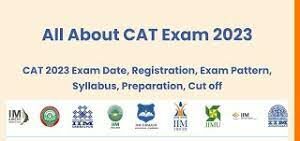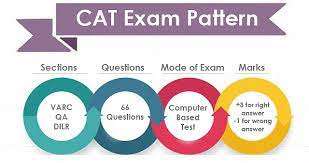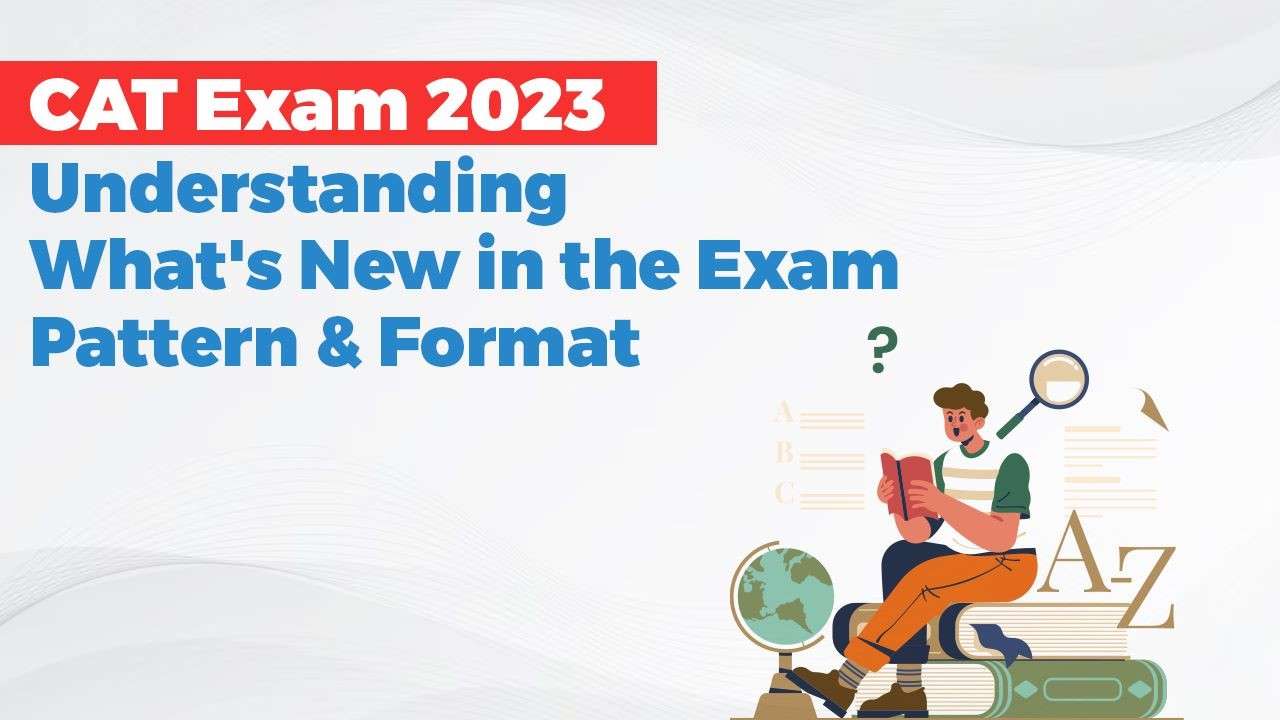The Common Admission Test (CAT) is India’s most prestigious national-level entrance examination, which permits aspirants to get into top management institutes. There is no doubt that it is the biggest MBA entrance test in the country. The IIMs (Indian Institute of Management) conduct this Common Admission Test annually on a rotational basis. IIM Bangalore was the conducting body for CAT 2022. For CAT 2023 IIM Lucknow will be the conducting body . The CAT exam is divided into three sections, namely Verbal Ability and Reading Comprehension (VARC), Data Interpretation and Logical Reasoning (DILR), and Quantitative Ability (QA). Each section is timed for 40 minutes, making for a total exam duration of 2 hours.

What is CAT VARC Syllabus 2023?
CAT’s Verbal Ability and Reading Comprehension (VARC) section evaluates a candidate’s proficiency in English language skills and reading comprehension. The syllabus includes topics such as vocabulary, grammar, critical reasoning, and passage analysis. Aspiring CAT takers need to focus on enhancing their language skills and developing the ability to comprehend complex passages.
What is CAT LRDI Syllabus 2023?
The Logical Reasoning and Data Interpretation (LRDI) section of CAT assesses a candidate’s logical thinking and data interpretation skills. The syllabus encompasses various topics, including data analysis, puzzles, graphs, and charts. To excel in this section, candidates should practice solving puzzles, analyze data sets efficiently, and strengthen their logical reasoning abilities.

CAT QA Syllabus 2023:
The Quantitative Aptitude (QA) section of the CAT entrance exam for the year 2023 assesses a candidate’s mathematical proficiency and problem-solving skills. This section is designed to evaluate the ability to work with numbers, solve mathematical puzzles, and apply quantitative reasoning to real-world scenarios. Let’s delve into the key components of the CAT QA syllabus for 2023:
Algebra:
1.Linear Equations:
Solving linear equations in one or two variables and their applications.
2. Quadratic Equations:
Factoring, roots, and solutions of quadratic equations.
3. Inequalities:
Understanding and solving inequalities.
Progressions:
Arithmetic and geometric progressions, along with their applications.
Geometry:
1. Lines and Angles:
Understanding properties of lines and angles, parallel lines, and transversals.
2. Triangles and Circles:
Properties of triangles, congruence, similarity, and circle theorems.
3. Quadrilaterals:
Properties of various types of quadrilaterals.
4. Mensuration:
Calculation of areas and volumes of geometric shapes.
Number Theory:
1. Factors and Multiples:
Understanding factors, multiples, and divisibility rules.
2. Prime Numbers:
Identifying prime numbers and their properties.
3. Remainders and Divisibility:
Solving problems involving remainders, divisibility, and prime factorization.
Number Theory:
1. Simultaneous Equations:
Solving systems of linear equations in two or more variables.
2. Inequalities:
Solving and graphing linear and quadratic inequalities.
3. Functions and Graphs:
Understanding basic concepts of functions and their graphical representations.
Important Topics for CAT Quantitative Aptitude Section
The Quantitative Aptitude (QA) section in the CAT entrance exam is a critical component that evaluates a candidate’s mathematical prowess and problem-solving abilities. This section encompasses a wide range of topics, each carrying its own weightage and significance. To excel in the CAT QA section, candidates should prioritize their preparation on the following important topics:
1. Number Systems
Understanding the properties of integers, rational and irrational numbers, and their applications. This topic serves as the foundation for various other concepts in mathematics.
2. Percentages and Ratios
Solving problems involving percentages, ratios, proportions, and variations. These concepts are frequently used in business and real-life scenarios.
3. Profit and Loss
Calculating profit, loss, cost price, and selling price in different business contexts. Mastery in this topic is essential to tackle related questions effectively.
4. Time, Speed, and Distance
Solving problems related to time, speed, distance, and their interrelations. This topic tests your ability to work with units and rates of change.
5. Algebraic Equations
Solving linear and quadratic equations, and working with expressions involving variables. Proficiency in this topic aids in solving a variety of mathematical problems.
6. Geometry
Understanding geometric properties, angles, lines, triangles, and circles. This topic tests spatial understanding and critical thinking.
7. Mensuration
Calculating areas, perimeters, and volumes of geometric shapes. Mensuration questions often require application of formulae in real-world scenarios.
8. Number Theory
Understanding factors, multiples, prime numbers, and divisibility rules. This topic forms the basis for more complex number-related problems.
9. Time and Work
Solving problems related to work done by individuals or groups in a given time frame. This topic evaluates efficiency and work allocation.
10. Probability and Statistics
Understanding concepts of probability, mean, median, mode, and standard deviation. These concepts are essential for data analysis and decision-making.
11. Permutations and Combinations
Solving problems involving arrangements and selections of items. This topic requires logical thinking and application of counting principles.
12. Quadratic Equations
Factoring, roots, and solutions of quadratic equations. A strong grasp of quadratic equations aids in solving higher-level problems.
13. Arithmetic Progressions
Understanding arithmetic sequences and series. This topic assesses your ability to work with patterns and progressions.
14. Geometry and Mensuration Applications
Applying geometric principles and mensuration formulae to solve complex problems involving real-world scenarios.
15. Data Interpretation
Analyzing and interpreting data presented in graphs, charts, and tables. This topic evaluates your ability to extract information accurately.

How to cover CAT exam syllabus - Important Tips
Preparing for the CAT exam demands a well-structured approach that covers the extensive syllabus effectively. The CAT syllabus includes various sections, each requiring dedicated attention and practice. Here are some essential tips to help you navigate and conquer the CAT exam syllabus:
1. Understand the Syllabus Thoroughly
Begin by comprehending the complete CAT syllabus. Familiarize yourself with the topics, subtopics, and question patterns in each section. This understanding will help you create a clear study plan.
2. Create a Study Plan
Devise a detailed study plan that allocates sufficient time to each section based on your strengths and weaknesses. Break down your study schedule into smaller, manageable segments to ensure comprehensive coverage.
3. Prioritize Weak Areas
Identify your weak areas within the syllabus and prioritize them during your study sessions. By focusing on areas that need improvement, you can gradually enhance your overall proficiency.
4. Refer to Reliable Study Material
Select trustworthy and comprehensive study materials such as CAT preparation books, online resources, and video tutorials. Make sure the materials cover the entire syllabus and offer practice questions and mock tests.
5. Practice Regularly
Consistent practice is key to mastering the CAT syllabus. Solve a variety of questions from different difficulty levels to build your problem-solving skills. Regular practice also helps you manage time effectively during the exam.
6. Solve Previous Years' Papers
Solving previous years’ CAT question papers gives you insights into the exam pattern, question types, and difficulty levels. It helps you develop a strategic approach and familiarizes you with the actual exam environment.
7. Take Mock Tests
Mock tests simulate the actual CAT exam conditions. Take full-length mock tests regularly to gauge your performance, identify weak areas, and improve your time management skills.
8. Analyze and Learn from Mistakes
After attempting mock tests and practice questions, analyze your mistakes and areas where you struggled. Understand the concepts you missed and work on improving them through targeted practice.
9. Revise Regularly
Set aside time for regular revision of the topics you’ve covered. Revision helps reinforce your understanding and ensures that you retain the concepts for the exam.
10. Stay Updated with Current Affairs
Keep yourself informed about current affairs and contemporary issues. This knowledge can be valuable in the Verbal Ability and Reading Comprehension section.
11. Manage Time Effectively
Time management is crucial during the CAT exam. Practice solving questions within the allocated time frames to ensure you can attempt all questions on the actual exam day.
12. Stay Positive and Persistent
CAT preparation can be challenging, but maintaining a positive attitude and staying persistent are essential. Believe in your abilities and keep pushing yourself to improve.

CAT Exam Pattern:
The CAT exam consists of three sections:
1. Verbal Ability and Reading Comprehension (VARC):
This section evaluates language skills and comprehension. It includes questions on reading passages, grammar, and vocabulary.
2. Logical Reasoning and Data Interpretation (LRDI):
This section assesses logical thinking and data analysis. It involves solving puzzles, graphs, and other logical problems.
3. Quantitative Aptitude (QA):
This section tests mathematical and problem-solving skills. It covers topics like arithmetic, algebra, geometry, and number theory.
Each section has a time limit of 60 minutes, resulting in a total exam duration of 180 minutes (3 hours).
Question Types
CAT features two types of questions:
1. Multiple Choice Questions (MCQs):
Candidates are presented with multiple options, and they must select the correct answer.
2. Non-MCQs (Type-in-the-Answer):
Here, candidates need to type their responses. These questions do not offer multiple choices, requiring candidates to be precise.
Scoring System
The CAT exam follows a marking scheme of +3 marks for each correct answer in both MCQs and non-MCQs. However, there is a penalty for wrong answers: -1 mark for incorrect MCQ responses. There is no negative marking for non-MCQs.
Sectional and Overall Percentile
The CAT exam evaluates candidates based on sectional and overall percentiles. The sectional percentile represents how a candidate performed compared to others in the same section. The overall percentile reflects the candidate’s performance across all three sections.
Variation in Difficulty Levels
CAT questions vary in difficulty levels. The exam employs a mix of easy, moderate, and challenging questions. A candidate’s performance across these levels contributes to their overall score and percentile.
On-Screen Calculator
CAT provides an on-screen calculator to aid candidates during the exam. However, candidates should practice using it effectively to save time and minimize errors.
Conclusion
Understanding the CAT exam pattern is crucial for adequate preparation. Aspirants must develop strong skills in each section and practice time management to tackle the diverse question types within the stipulated timeframes. By familiarizing themselves with the structure and nuances of the exam, candidates can approach the CAT with confidence and increase their chances of securing admission to esteemed management programs.
FAQ's
Lorem ipsum dolor sit amet, consectetur adipiscing elit. Ut elit tellus, luctus nec ul
- Verbal and Reading Comprehension.
- Data Interpretation & Logical Reasoning.
- Quantitative Ability.
lamcorper mattis, pulvinar dapibus leo.
The CAT can be taken only once every year on a date specified by the convening IIM. The date on which the CAT will be conducted is announced by the convening IIM in July or August of every year. There is no restriction on the number of attempts you can take the CAT and no upper age limit.
DILR proves to be the trickiest question of CAT owing to the unpredictability of the questions and lack of syllabus.
The qualifying CAT cut off is fixed category wise. The cut off for General category students is high (90), while for reserved category students, it is low (70 and below). The final CAT cut off is fixed category wise.








